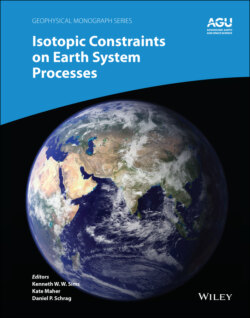Читать книгу Isotopic Constraints on Earth System Processes - Группа авторов - Страница 68
3.1. INTRODUCTION
ОглавлениеUnderstanding the fluxes of carbonate sediment between subducting plates and the overlying mantle wedge and magmatic arc is important because sediment fluxes control mantle heterogeneity and influence the global carbon cycle. In particular, when large amounts of CO2 (as carbonate) are subducted, they affect Earth’s climate (DePaolo, 2004). In this study, I use calcium isotopes to track recycled carbonates in subduction‐related magmas because the global calcium and carbon cycles are linked through carbonate formation.
Traditionally, insights into the differentiation history of the mantle come from radiogenic isotope measurements of oceanic basalts, e.g., DePaolo and Wasserburg (1977), Lassiter et al. (1996), and Stille et al. (1983). These observations can be used to study the origin and evolution of compositionally distinct mantle reservoirs. Subduction processes play an important role in the differentiation of the mantle, as they can transport distinct materials into Earth’s interior. In fact, geochemical and isotopic systems (e.g., Sr, Nd, Pb) have been used to suggest that subducted marine sediments are important to the petrogenesis of ocean island basalts, even when far from any existing plate margin, e.g., Blichert‐Toft et al. (1999), Cabral et al. (2013), Castillo et al. (2018), and Huang and Frey (2005). Accurate interpretation of these mantle signatures is complicated by the fact that both changes in source composition and time can lead to isotopic heterogeneity.
Mass‐dependent stable isotope compositions complement radiogenic isotope signatures because they are not affected by age. Calcium isotope measurements of primitive igneous rocks have the potential to provide a powerful tool to test ideas about the various possible sources of mantle heterogeneity. This is because both radiogenic and stable calcium isotopes can be measured, e.g., DePaolo (2004), Huang et al. (2010; 2011), Simon and DePaolo (2010), and Simon et al. (2009). Furthermore, significant stable mass‐dependent calcium isotope variability is not expected to originate at mantle solidus temperatures under which oceanic basalts have been generated (>1200–1500○C), e.g., Putrika (2005). This is understood implicitly by the growing number of studies based on mantle‐derived rocks that exhibit a similar calcium isotopic composition, e.g., Amini et al. (2009), Amsellem et al. (2019), Antonelli and Simon (2020), Chen et al. (2019a,b), DePaolo (2004), Huang et al. (2010; 2011), Jochum et al. (2006), Kang et al. (2017), Simon and DePaolo (2010), and Wombacher et al. (2009).
Subduction and recycling of sediments, in particular marine carbonates, could introduce distinctive calcium isotopic variations within the mantle because marine carbonates generally have lower values, i.e., lighter isotopic compositions than most igneous rocks by up to several per mil (De La Rocha & DePaolo, 2000; DePaolo, 2004; Fantle & DePaolo, 2005; Farkas et al., 2007; Griffith et al. 2008; Heuser et al., 2005; Kasemann et al., 2005; Watkins et al., 2017; Zhu & MacDougall, 1998). This isotopically light signature is commonly understood to reflect mass‐dependent biological fixation of Ca2+ into the carbonate sediments, which is a function of seawater temperature and growth kinetics, but also depends on the calcium isotopic composition of seawater that can fluctuate because of calcium input to the ocean from weathering of continental rocks and ocean floor basalt (De La Rocha & DePaolo, 2000; DePaolo, 2004; Nielsen Lammers et al. 2020). Relatively light calcium isotope ratios in Hawaiian basalts and some other mafic igneous rocks have been attributed to crustal recycling (Banergee & Chakrabarti, 2019; Chen et al. 2018; Huang et al., 2011; Kang et al., 2016, 2017; Liu et al., 2017), but the interpretation of the results is debated (Antonelli et al., 2019a; Ionov et al., 2019).
In order to help evaluate the role that carbonate recycling plays in the evolution of Earth’s atmosphere and to explain isotopic heterogeneity in mantle‐derived rocks, I have measured the mass‐dependent calcium isotope compositions of modern arc basalts from Central America. In these lavas, more traditional geochemical signatures of carbonate sediment recycling have been observed, including enrichments in large ion lithophile and fluid‐mobile incompatible trace elements, short‐lived 10Be abundances, heavy stable Li isotopes, and radiogenic isotopes (Chan et al., 2002, 2006; Feigenson et al., 2004; Leeman et al., 1994; Morris et al., 1990; Nyström et al., 1988; Patino et al., 2000; Sadofsky et al. 2008). Likewise, I report mass‐dependent calcium isotope measurements for young carbonatite magmas (Oldoinyo Lengai, Tanzania, and Laacher See, Germany) to further test the role that subducted sediment might have on the heterogeneity of the mantle and to address the active debate as to whether such exotic carbonatite magmas originate from low degree partial melting of a primitive mantle source or from recycling of carbonate‐rich surface material through subduction, e.g., Bell and Tiltonm (2002), and Walter et al. (2008).
